BFGoodrich KO2 in the Snowy Hills of Maine
Posted on Sep 19, 2016 in Editorials | 1 comment
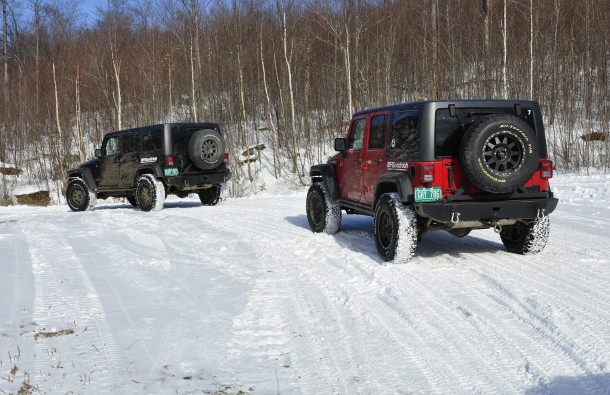
BFGoodrich’s All-Terrain T/A tires can be found everywhere, from your local construction site to the most grueling of off-road races. I’ve fitted some of my trucks with the original KO and used them on and off-road, so I was curious what improvements BFGoodrich could bring to its latest iteration: the new KO2.
BFGoodrich brought me up to Bethel, Maine to test out its new tire in the nearby hills — and to catch this year’s Red Bull Frozen Rush.
The Frozen Rush trucks run a one-off spiked version of the same tire, but I was more interested in the street version that might adorn one of my (or your) vehicles.
It was quickly apparent the KO2’s thicker shoulder had deviated from the traditional KO design. Along with that bulkier shoulder was a new serrated pattern on the sidewall. The aggressive features certainly looked fit for an off-road adventure, so that’s just what we did.
After a brief morning presentation, we were taken to the off-road course to meet our instructors from the 4×4 Center in Vermont. It was there that we were introduced to a fleet of Jeep Wranglers shod in the new BFGs. Since my group had an odd number of people, I was lucky enough to get a Wrangler to myself.
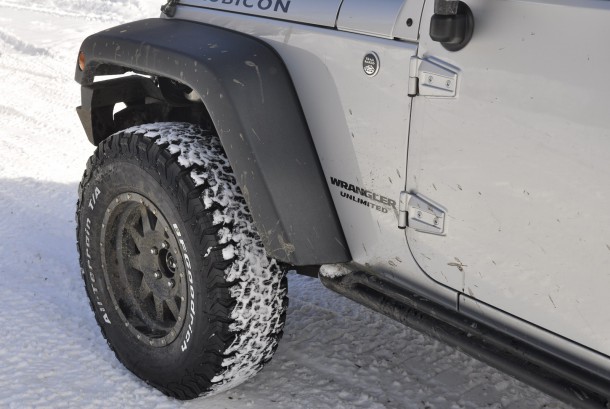
For starters, the Wrangler Rubicons we used for the test had very few modifications: The bumpers were replaced with off-road versions to allow winching, and the underside was coddled by skid plates to protect the drivetrain. The tires were off-the-shelf KO2 units aired down to around 15 PSI in order to match the terrain. Interestingly enough, my instructor had personally driven that Wrangler from Burlington, Vermont on the exact tires we were about to take out on the trail.
The driving instructions were simple: Start in a lower gear and make use of left-foot braking. The trail was a perfect mix of snow, ice and mud thanks to a rise in temperature. That gave us the perfect opportunity to try out an array of surfaces. The KO2 wears the mountain snowflake symbol on its sidewall that designates it as a winter tire. I wanted to know if the designation was worth more than the rubber it was stamped on.
Taking off on the trail in last position gave us a good view of the vehicles in front. It was quickly apparent the Jeeps in front of me were moving with ease; snow flew from the treads as the Jeeps moved along the course. This gave me a bit of reassurance to push my Rubicon harder.
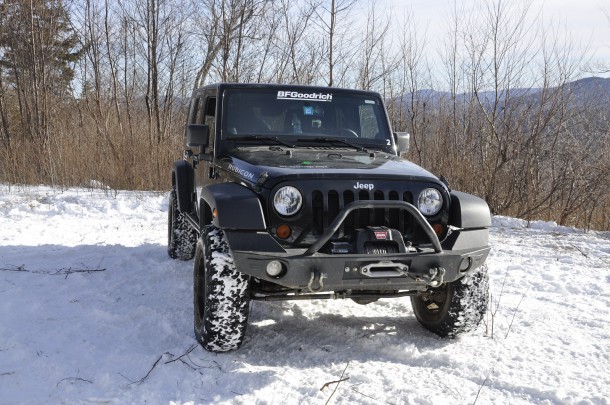
The first goal was to hunt for ruts filled with mud and rocks in order to test the veracity of BFG’s much-touted stone ejector technology claims. The stone ejectors, small nubs between the tread blocks, are meant to wiggle and push out foreign objects. I was successful in tackling some pits filled with small pebbles and rocks. True to form, most of those rocks were spit right out of the tire’s tread — but pushing the Jeep deep into some of the mud holes resulted in nabbing a pebble between the brake pad and rotor of one of the front wheels.
The brakes got noisy from the lodged pebble. After an inspection and a few, erm, quick maneuvers, it was dislodged.
Later, one of the hills included a deep trench that was followed by a quick right turn. We spent a not inconsiderable amount of time on that hill: the first journalist in the group let off the throttle as they were going into the trench and got themselves stuck. After some direction from the instructor, they were able to back up and move through while keeping a steady throttle.
Not wanting to make the same mistake, I pointed the Jeep about five feet to the right of the others.
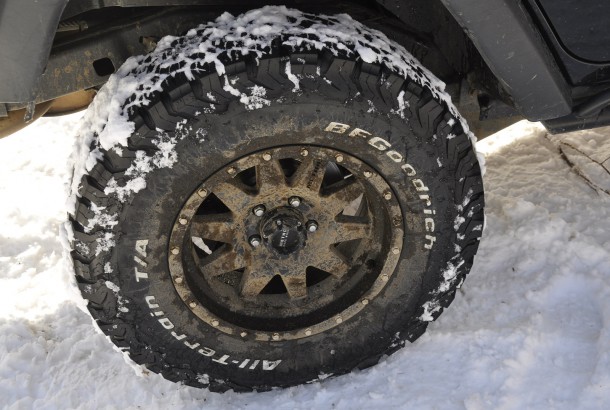
Passing the trench brought the revelation that we had entered into a combination of slush, rocks, and mud. In my haste, I made the mistake of letting off the throttle just like the other member of our group and got the Jeep stuck. The instructor advised locking the hubs and rolling the Jeep back to try again. After backing up and adjusting course slightly, we were able to cross the trench easily. At the next rest stop, inspection revealed that the the adventure with the rocks had scraped some of the paint on the wheels and smeared them with mud. The tires, on the other hand, showed no trace of damage.
The Jeep and tires were pushed further as the trip progressed, but no matter how hard they were pushed and what surfaces they encountered they would not slide off trail or get stuck.
The trail adventure concluded with a visit to the pits of Frozen Rush. The racers went over a few points similar to what the BFGoodrich PR team had covered, but the most important fact that they all shared was that the tires lasted longer and suffered fewer punctures than the previous tire.
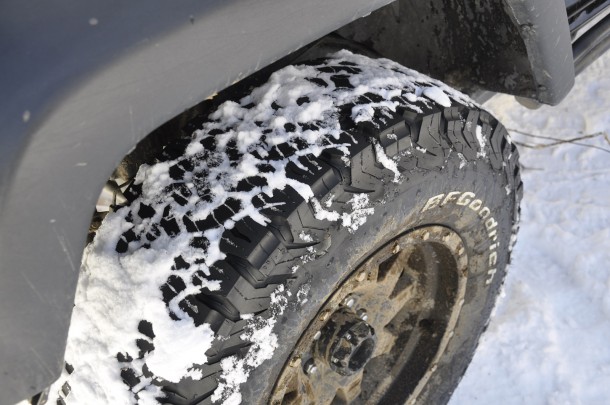
The Jeep with BFGoodrich’s KO2 tires proved to be the same. Sliding against the rocks only added a few scratches and gouges to the wheels; the tires were none the wiser. The KO2 was a great performer on the trail and shows a marked improvement over the KO in off-road conditions.
Now, if I can just get some of these for my WRX …





.gif)


I like the tire test concept – but this reads a bit like a puff piece. There just isn’t much here beyond MFG PR stuff and a few anecdotes about capabilities. I bet this course could have been tackled by a Rubicon shod in just about any rubber.